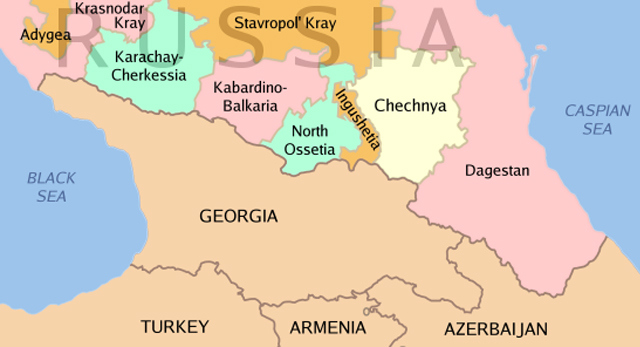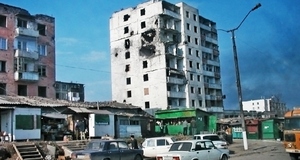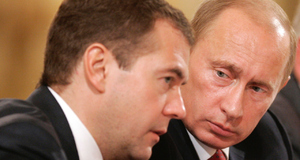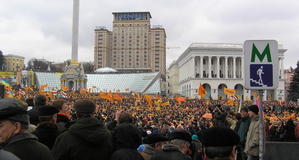From Cornell International Affairs Review VOL. 6 NO. 1Campaign of Devastation: Assessing Motives for the Russian Government's 1999-2000 Destruction of Chechnya
IN THIS ARTICLE
KEYWORDS
AbstractIn 1999, the Russian government all but razed Chechnya’s capital city of Groznyy. The Russian military devastated Chechnya, killing thousands of civilians and wiping out vital infrastructure, signifying the capstone in a campaign of destruction inflicted on Chechnya to crush the burgeoning separatist movement. Government-rebel attacks like this one occur when governments seek to end insurgent campaigns by using force to kill rebels and destroy their base of support.1 The unusual paradox in the Russian-Chechen conflict was that the Russian government’s ultimate intent was to stop the Chechen separatist movement and re-absorb Chechnya into the Russian Federation, and yet the damage it chose to inflict on the region was unimaginable in its scope and extent. Why would a government, in effect, completely destroy its own land and ruin what it considers its own infrastructure and part of its economy? Why would a government want to inflict massive pain, suffering and death upon enormous numbers of civilians that it considers to be legitimate members of its own nation? At face value, nothing appears more ludicrous than a government murdering its own civilians and scorching its own earth. This paper endeavors to prove, however, that such brutality was not paradoxical, but had underlying normative and strategic value for the Russian government. HypothesesWhy would the government harm its own land in an exceptionally brutal manner? At face value, this seems to be a counterproductive course of action. I postulate, however, that the Russian government’s actions during the Chechen conflict were not paradoxical or counterproductive at all, but instead laden with normative and strategic value. I propose the following as the overriding motivation for the Russian government’s use of overwhelming force in Chechnya, as exemplified by the 1999- 2000 offensive:
I argue that the Russian campaign of destruction in Chechnya was considered a vehicle for messages about the power of the state and was used to threaten future rebellions with brutal retaliation. Russia had just emerged from the Cold War when it decided to initiate the first Chechen War; this campaign appears to be a move to not only restore its international reputation as a powerful state but also deter groups that wanted to push for secession from the Russian Federation.2 The second Chechen offensive, the subject of this paper, was also initiated during a period of internal political change. The domestic political events that influenced the government’s decision to engage in the 1999-2000 offensive are discussed in this paper. In addition to the normative argument, I propose two other hypotheses focusing on the strategic aspect of the violence:
Civilian life in Chechnya had certainly become unbearable by 1999.3 The Russian government was using overwhelming violence to literally crush the rebellion, but also to undermine support vital to its continuation as an insurgent movement.
If the government succeeded in destroying vital infrastructure, ruining agricultural sites, and destroying cities and major economic centers, the rebels would face a difficult period of reconstruction in the event of a successful secession. Such devastation could deter secession entirely or provide a safeguard if secession were successful, in that the state may be able to re-establish economic and social control of the newly independent region in the period of intensive reconstruction when the new state is weak and reliant on external aid. The Russian government therefore had a strategic interest in destroying Chechnya: while the government was hurting its own territory, it was in effect trying to destroy its own land in order to retain it. Brief Overview of the Conflict in Chechnya4The Russian-Chechen conflict grew out of the breakup of the Soviet Union. During the Soviet era, Chechnya had been an autonomous republic in the USSR; after the fall of the Soviet Union, however, the Chechens fought their absorption into the Russian Federation and declared themselves the Chechen Republic of Ichkeria. Russian forces fought to put down the separatist movement in two phases, the first from 1994 to 1996 and the second from 1999 to 2007. During the first phase of the conflict, President Boris Yeltsin headed the Russian government. During the second phase, the government was lead by President Vladimir Putin, who was acting Prime Minister after Yeltsin’s 1999 resignation and won the presidency in 2000. In response to demands for autonomy among the Chechen people, elections were held in Chechnya in 1991. Dzhokhar Dudayev was elected president, although the elections were not recognized by the Russian Federation. Dudayev’s supporters seized territory in the capital, Groznyy, and for the next three years refused the Russian Federation’s offers for taking on the status of Republic within the Federation. In 1994, Russian military forces launched the first full-scale military invasion into Chechnya, beginning the Russian-Chechen war in an attempt to crush the rebel movement. The first phase of the war was largely considered unsuccessful for the Russians. The conflict was marked from the beginning by extreme and widespread violence against civilian areas and populations on the part of the Russian army. The destruction of the capital city Groznyy and countless other cities and villages in Chechnya destroyed much of Chechnya’s infrastructure and in many cases reduced areas of the country to rubble.5 The best estimates state that through 12 years of active conflict, about 17,600 people were killed, with 17,500 to 33,393 deaths falling under the possible range.6 Details of the 1999-2000 Russian OffensiveThe second Chechen offensive began in September 1999 and continued until the spring of 2000. It was marked by “artillery and air strikes on populated places” and intense destruction, especially in the capital city of Groznyy.7 The US Country Report on Human Rights Practices for Russia notes that “in September and early October, government forces launched air and artillery attacks against numerous Chechen villages along the republic’s eastern border with Dagestan,” and “attempts by government forces to gain control over Chechnya’s capital, Groznyy, were characterized by indiscriminate use of air power and artillery, which destroyed numerous residential and civilian buildings.” The report relayed ICRC estimates of two-thirds of the 150,000 civilians in Groznyy fleeing the capital as a result of the Russian offensive.8 On October 27, 1999 the heaviest bombardment yet occurred within in the second phase of the conflict, resulting in 116 deaths from the Russian bombings.9 The Russian news agency Interfax reported that from October 27 – October 28 alone, the Russian air forces flew 150 sorties over Chechnya.10 While the Russian government claimed to use high-precision weapons, reports indicate that they in fact relied mainly on unguided missiles, which were not precise enough to guard against unnecessary civilian casualties.11 The US Country Report on Human Rights Practices for the year 2000 reported on the results of the campaign, indicating that: There were some reports that federal troops purposefully targeted some infrastructure essential to the survival of the civilian population, such as water facilities or hospitals. The indiscriminate use of force by federal troops resulted in massive destruction of housing and commercial and administrative buildings, as well as the breakdown of gas- and water-supply facilities and other types of infrastructure.12 This is evidence that the Russian campaign of 1999-2000 was not only costly in terms of lives lost but also in terms of the amount of devastation wrought on regional infrastructure. As journalist Anna Politkovskaya would later note, the Russian government indeed succeeded in turning Chechnya into “a small corner of Hell.” Russian Devastation of Chechnya as a Normative Mechanism – Signaling Power to Internal and External ActorsWith basic historical background of the conflict established, it is possible to examine the government’s potential motives for such brutality. It is clear from an examination of the circumstantial evidence surrounding the offensive, as well as a synthesis of the available primary sources, that the offensive in Chechnya was an attempt to signal Russian strength both to internal and external actors. It is also clear that Putin used the situation to bolster his own political reputation. This section describes the domestic political situation of Russia in late 1999 and its relationship to the decision to launch the offensive as a signal to internal and external actors. Political Circumstances Surrounding the 1999 OffensiveNewly appointed Prime Minister Vladimir Putin was responsible for launching the second Chechen offensive in August of 1999. Putin was operating under the widespread normative assumption in Russia that Yeltsin’s first offensive had been a failure: Thornike Gordadze notes that “…Putin and the military swore not to repeat the mistakes of the first war and from the start pursued a strategy of massive daily aerial attacks followed by the advance of ground troops, disregarding the number of civilian casualties this would provoke.”13 Russia was also reeling from the bombings of Moscow apartment buildings, supposedly carried out by Chechen terrorists in September 1999.14 Because Putin would be facing a competative presidential election in March of 2000, it is likely that he wanted to take action to enforce his hard-line stance against crime and back up his image as a no-nonsense politician who would work to keep the territorial integrity of Russia intact.15 According to Gordadze, “the outbreak of the second Chechen war in October 1999 came just at the right moment: it sidelined political debate over who would succeed Boris Yeltsin and consolidated the electoral rise of his prime minister, Vladimir Putin.”16 Domestic Political Environment and its Relation to Internal SignalingBarbara Walter’s work on reputation and civil war postulates that in separatist conflicts, the state has strong incentives to pay the costs associated with reputation building, like engaging in long, bloody, and expensive military endeavors, because it faces the prospect of repeated play. Russia, an ethnically heterogeneous state, was operating under the threat of what Walter deems repeated play – Putin engaged in the Chechen offensive as a visible warning to other ethnic groups in Russia that threats of succession would be met with violence. Walter relays: “as one Russian political scientist aptly observed: ‘the fighting in Chechnya was not just against the Chechen rebels, it was against movements all around’.”17 As Monica Toft similarly posits, states face an impetus to keep their territory intact, because the breakup of a state’s physical territory could spell its demise.18 The problem confronting Russia was that it believed that it potentially faced a series of separatist movements, and thus had incentive to brutally suppress the Chechen movement rather than offer political concessions. This is because the war itself would bolster Russia’s – and Putin’s – reputation for decisive and bloody action in the face of rebellion, and in their anticipated outcome, future rebels would choose to remain subservient to Moscow rather than take up arms, out of fear for how the Russian government would react.19 The available historical evidence backs this claim. In 1999, there was significant domestic political unrest in Russia. Putin could have realistically expected to face separatist challenges in several surrounding regions, and was also dealing with numerous ethnic and minority groups that were unhappy with their standing in the Russian Federation. The Karachay-Cherkessia region was experiencing large-scale, non-violent unrest from 1999- 2001 regarding a disputed election, which the government may have feared could foster a potentially violent separatist movement. The Dagestan region was also in turmoil, with groups like the Lezgin demanding the creation of an ethnic state; although the region seemed willing to compromise on their most radical demands at the time, there was still the potential for a violent movement to arise. Moscow was also engaged in negotiations with Tartarstan to forestall secession during this time.20 The government was also likely still scarred by the dissolution of the Soviet Union in 1991 and the accompanying separatist movements that led to radical loss of territory. Walter’s argument also sheds light on Putin’s personal motivations for pursuing the second Chechen offensive in a highly brutal manner. She posits that the longer a leader plans on holding office, the more likely he is to resist territorial challenges, because he can anticipate a greater number of challenges arising during his tenure.21 Putin likely hoped that he would hold the office of President for some time; his predecessor Yeltsin had held the position for eight years, and Russian politicians have historically had a relatively long span of influence and office holding within the government.22 Therefore, it was sensible for Putin to take costly action very early on in his political career, even before officially gaining office, in order to forestall rebellion during his assumedly impending presidency. As Benjamin Valentino notes, “an understanding of mass killing must begin with the specific goals and strategies of high political and military leaders…sometimes even individual leaders can play a decisive role in instigating and determining the course of the slaughter.”23 It is likely that the brutal nature of the 1999-2000 Chechen offensive was driven in large part by Putin’s dictates and his desire to forestall repeated play combined with his concern for his personal reputation in Russia’s domestic political sphere. The Russian and international media certainly spoke at length about how Chechnya was an important early test for Putin, and how his actions fit with his “tough-man” image. As Jamie Walker reported for The Australian on December 11, 1999: Chechnya is as much about Putin’s political ambitions as it is about cleaning up this troubled corner of the Caucasus. And as a political strategy, it has worked brilliantly. Earlier this year, he was attracting just 2 per cent of support in presidential polls. By the time Russian aircraft began pounding the Chechen rebels’ strongholds in September, it was up to 14 per cent. In recent polls his numbers have trebled again, catapulting him into favoritism for the presidential elections… In Russia, if nowhere else, Putin’s war is a popular one. The reasons for this are complicated, reflecting public nostalgia for the might and power of the old Soviet Union and exasperation with the lawlessness that spilled across the borders of Chechnya and arguably into the Russian heartland itself. The campaign in Chechnya was Putin’s introduction onto the world stage. Before the Chechen campaign, Putin was “a political nobody” with a “strictly limited future in Boris Yeltsin’s Kremlin.”24 Nikolai Ulyanov stated in the Russica Izvestia on August 11, 1999 that when Putin was named Acting Prime Minister, he had “to act quickly in order to demonstrate that the President [Yeltsin] has made the right choice.” Ulyanov also stated that “the Kremlin expects Putin to demonstrate toughness to the nation” and that quick action in Chechnya could “confirm his reputation as a tough Prime Minister and enhance his authority in the military community.” If the violence in Chechnya was indeed a ploy to bolster Putin’s military image, it worked not only on a domestic scale, but on an international scale as well Polling from the Levada Center, a Russian public-opinion collection agency, lends credibility to Putin’s logic of using Chechnya as a signaling mechanism and reputation-enhancer. When polled in December 1999, 30 percent of respondents said that the Russian government should prevent the separation of Chechnya “by all possible means,” with a further 16 percent saying that they were against the separation but could accept it. Only 20 percent of those surveyed said that they supported such a separation. When polled in July 2002, a staggering 67 percent of respondents reported that they felt Chechens only understood “the language of force” and would interpret attempts to negotiate as a sign of Russian weakness. To that end, in December 1999, 68 percent of respondents felt that it was necessary to continue military operations rather than enter into negotiations. The Russian people certainly supported the use of force in Chechnya and were opposed to a potential separation of the region, even after witnessing the 1999-2000 campaign of destruction. Therefore, on a domestic level, Putin had much to gain reputation-wise from a tough stance in Chechnya – he was a relative newcomer to the Russian political stage, facing an election for the presidency in just a few months, and attempting to disprove Russia’s view of the President as a failure and a weak figure. Today, Putin’s brutal and bloody strategy seems to have succeeded in bolstering his reputation, as he will now be entering his third term as president and 13th year in the Kremlin. Putin also managed to contain many of the potential separatist movements, indicating that he succeeded in his goal of cultivating a reputation for decisive and brutal action. The Offensive and the Russian Image on the International StageIf the violence in Chechnya was indeed a ploy to bolster Putin’s military image, it worked not only on a domestic scale, but on an international scale as well. International leaders rushed to condemn the brutality; Celestine Bohlen reported for The New York Times on December 8, 1999 that “from Washington, President Clinton has warned Moscow that it will pay ‘a heavy price’ if it continues killing civilians.” The same article also reported that “in Britain, Foreign Secretary Robin Cook said aid from the European Union to Russia would be reviewed… if the Russian military did not observe ‘basic humanitarian norms.’” The Agence France-Presse announced on December 14, 1999 that “UN High Commissioner for Human Rights Mary Robinson, speaking in Geneva, described the plight of Chechen civilians as ‘unacceptable.’” While these are words of condemnation, and thus damaging to Russia’s reputation, they also signify the strong disproval of the offensive actions of the Russian military by international actors. Russia may have calculated that having a reputation for brutality in the international system was better than having no reputation at all, or a reputation for having lost the power it had held while it was the Soviet Union. While this judgment may have hurt Russia’s international reputation and hearkened back to the killing of civilians under the Stalinist regime, it would have furthered Russia’s domestic purpose by demonstrating that the Russian military was not only wiling to crush any separatist rebellion, but was also willing to do so in the face of international criticism. The Levada Center reported that in February 2001, 58 percent of Russian poll respondents said that they thought Russia had reason to fear NATO – this could imply that there was popular domestic support for the bolstering of Russia’s reputation for ferocity in the face of military challenges.25 As Chollet and Goldgeier note, “after Yeltsin stepped down from office at the end of 1999, the new president, Vladimir Putin, sought to reassert Russia’s traditional place in world affairs as a country to be reckoned with.”26 It remains to be seen if Russia will be resurgent, but there is no doubt that the international community recognizes that Russia is still in many ways a power to be reckoned with, and an actor prone to using violent force. Assessment of the EvidenceThere is substantial evidence to support the claim that the Russian government used the violence in Chechnya as a “shock and awe strategy” to signal its strength to other actors in the Russian Federation that may have been considering secession. The conflict also made an impression on external actors and possibly gave the Russians back some of their reputation for ruthlessness that they had lost since the breakup of the Soviet Union. The 1999-2000 offensive was also able to build Putin’s reputation as a tough leader, and contributed substantially to his election as President in March 2000. The devastation thus served three related normative purposes, and proved valuable to Russia.Continued on Next Page » Suggested Reading from Inquiries Journal
Inquiries Journal provides undergraduate and graduate students around the world a platform for the wide dissemination of academic work over a range of core disciplines. Representing the work of students from hundreds of institutions around the globe, Inquiries Journal's large database of academic articles is completely free. Learn more | Blog | Submit Latest in Political Science |



















